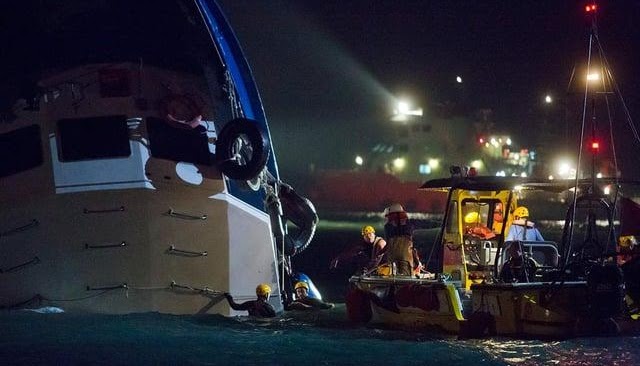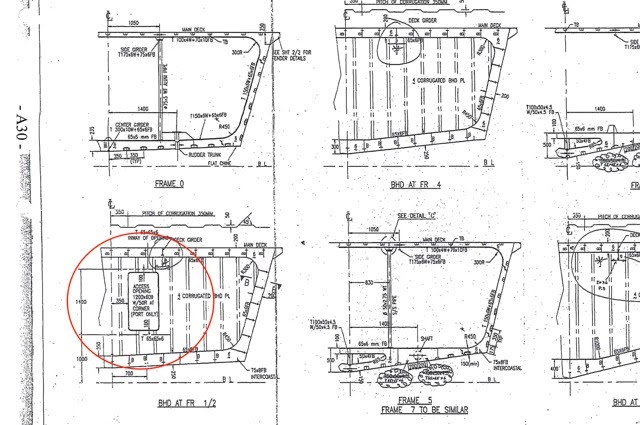2012 Lamma Island Death Reports
Part 2: Police investigation of the missing watertight door. The shipyard drawing company’s contradictory statements
Originally published: 07/12/2021 11:43 a.m. Stand News
In the Lamma ferry collision that claimed the lives of 39 passengers nine years ago, the key to the serious casualties was the lack of a watertight door on Lamma IV. This caused three cabins to sink rapidly into the sea after the collision in less than two minutes. The death investigation report obtained by Stand News revealed that the police had conducted a comprehensive investigation into the blueprints, sink resistance data, and shipbuilding procedures regarding the “missing watertight door,” and that there were conflicting statements from the shipyard drawing company and shipyard personnel.
The report also revealed that Cheoy Lee Shipyard was notified by an outsourced shipyard in 1995 that it needed to install watertight doors on the hull of Lamma IV after it arrived in Hong Kong; some Cheoy Lee employees told the police that they had seen the documents and admitted that Cheoy Lee was responsible for the construction of the access port, but a director of Cheoy Lee denied it to the police.
Stand News sent an email inquiry to Cheoy Lee Shipyard last Friday (3rd of December). Reporters also visited the residence of Director Lo Tsat-ying and the shipyard office to present inquiries to him, his domestic helper, and shipyard staff. However, no response was received before the deadline.
After the collision, Lamma IV sank in less than two minutes. The independent investigation report later said that the “disappearing watertight door” was the main reason for the rapid sinking of Lamma IV, and a large number of passengers were trapped inside the ship.
(Photo by Lam Yik Fei / Getty Images)
The director of the drawing company: the designs were wrong, and the draughtsman said he did not know about it.
The 2013 independent Commission of Inquiry’s expert witnesses and the shipbuilding engineer commissioned by the police concluded that the ship would not have sunk as fast as it did if there had been a watertight door between the tank room and the wheelhouse, as shown on the blueprint.
The death investigation report obtained by Stand News revealed that the police had taken statements from the director and draughtsman of the Singaporean drafting company Naval-Consult Pte Ltd. The director told the police that the watertight door was not expected to be installed when Lamma IV was designed, saying that the draughtsman had mislabeled it and that he only discovered it after the accident.
However, the draughtsman denied that he had made a mistake and said he did not know who had added the “WT” (Watertight) mark on the plan. He also said that he always submitted drawings to his supervisor, the director, for approval. The two statements show that the two men accused each other of responsibility, and the police report did not state whether any further investigation was carried out.
Finance director Lo Zhanying: wrong calculations submitted by the manager; Manager: I submitted before the directors needed to approve.
According to the report of the independent investigation of the maritime disaster, there had been miscalculations of the sink resistance data of Lamma IV. This subsequently led to the Marine Department’s decision in 1998 to pressurize the ship, which increased the ship’s weight by 30% and weakened its buoyancy. If the Marine Department had calculated the sinking data accurately and known about the omission of the watertight doors at the time, “there is no doubt that Lamma IV would not have been allowed to sail.”
The police later followed up on the issue of incorrect sink resistance data and found another expert witness who confirmed that the sink resistance data submitted was based on six watertight compartments, but since there was only a passage between the tank room and the wheelhouse of Lamma IV and no watertight doors, there were actually only five watertight compartments on the ship.
A director of the company surnamed Lo told the police that the wrong sink resistance data was submitted to the Marine Department by the former Spanish assistant manager of the engineering department and said it was unclear whether the others had seen the data. The independent Commission of Inquiry list of witnesses showed that Lo was the only director of the company to testify.
The police found the assistant engineering manager in Spain in 2018 through mutual legal assistance, but he told the police that he was only responsible for administrative work, and that plans and documents had to be approved by a director of the shipyard, Ken Lo, before they could be submitted to the Marine Department. Lo Zhanying’s English name is Ken Lo.
The 1995 profile and bulkhead plan submitted to the Marine Department by Cheoy Lee Shipyard showed an access opening in the bulkhead between the tank room and the steering gear room (circled in red) but did not indicate that a watertight door would be installed. However, the shipyard incorrectly calculated the stability of the breakout on the basis of the presence of a watertight door in the steering gear room.
The document proves that the shipping company was notified of the need to install watertight doors. Lo Zhanying: no memory of ever seeing it.
The police found two documents showing that Wuzhou Shipyard, which was commissioned by Cheoy Lee to build the hull, had informed Cheoy Lee in 1995 that it needed to install a watertight door between the fuel tank room and the steering gear room after the hull of Lamma IV arrived in Hong Kong. These are the first documents to confirm.
A staff member of the engineering department, surnamed Fung, admitted to the police that the documents were sent to him by Wuzhou Shipyard and confirmed that the access port between the tank room and the steering gear room of Lamma IV was built by Cheoy Lee but said he could not remember when it was built.
However, Lo Zhanying denied to the police that he had seen the two documents. When asked whether Cheoy Lee had made any holes in the hull of the Lamma IV, he responded “No, it was only built according to the ship’s plans.” The police then took a statement from Lo for the second time, asking whether the access port was built by Cheoy Lee or Wuzhou Shipyard. Lo said he did not know.
Stand News emailed Cheoy Lee Shipyard and went to the residence of director Lo Ts’ai-ying and the shipyard office to ask for him, but there was no response before the deadline.
Police: no one in Cheoy Lee has to bear the responsibility; Family member and survivor Zhao Bingquan: those involved are shifting blame
The investigative report shows that the police interviewed a total of 12 staff members, including directors, managers, and engineers of the company. The police concluded that the investigation found that no one at Cheoy Lee could say when the access port was built, no one had the responsibility of verifying the plans and ensuring that the ship was built according to them, and the draftsman who calculated the sink resistance data did not know the actual condition of the ship.
Zhao Bingquan, who survived the disaster but lost his sister, said that the testimony revealed that all parties involved, even the ship factory and the shipyard drawing company, were pushing their responsibilities. “I feel that they are pushing the blame onto on a Spanish person, thinking that they can get avoid responsibility, but the other party is shifting their responsibilities by saying, ‘I don’t know, I signed it. I think the coroner’s court has a procedure, if you don’t testify, you don’t talk, you have to face the responsibility or punishment. I am feeling very frustrated.”
Next: Part 3
Police’s meeting with the senior management over working hours. Hong Kong and Kowloon Ferry refused to assist in investigation.

